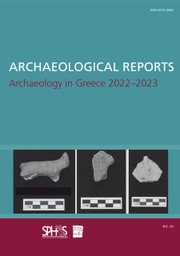Article contents
Stone quarrying in Greece: ten years of research
Published online by Cambridge University Press: 13 February 2018
Extract
It has been ten years since the publication of Lorenzo Lazzarini's monumental volume on the quarrying, use and properties of the coloured marbles of Greece: Poikiloi Lithoi, Versiculores Maculae: I Marmi Colorati della Grecia Antica (Lazzarini 2007). The first study since Angelina Dworakowska's Quarries in Ancient Greece (Dworakowska 1975) to attempt a large-scale examination of quarrying across Greece, Lazzarini's approach is fundamentally an archaeometric one. Analysis of the evidence for quarrying in different regions is set alongside minero-petrographic and geochemical analyses of the materials extracted. Lazzarini focuses on 12 lithotypes: marmor lacedaemonium from Laconia, variously referred to as serpentino and porfido verde antico; three stone types from the Mani peninsula: rosso antico tenario, nero antico tenario and cipollino tenario; from Chios, the famous marmor chium or portasanta, breccia di Aleppo and nero antico chiota; the breccia di settebasi and semesanto of Skyros; the intensively exploited marmor carystium or cipollino verde, as well as the marmor chalcidicum or fior di pesco from Euboea; and from central and northern Greece, marmor thessalicum or verde antico and the breccia policroma della Vittoria. For each of these lithotypes, Lazzarini considers the evidence for their use and distribution, illustrated with a distribution map in each case, and provides a thorough overview of what is known about their quarries. Archaeological and geological approaches are here combined, and this is a hallmark of much recent work on the question of quarrying and stone use through Greek history.
- Type
- Archaeology in Greece 2016–2017
- Information
- Copyright
- Copyright © Authors, the Society for the Promotion of Hellenic Studies and the British School at Athens 2017
- 5
- Cited by




